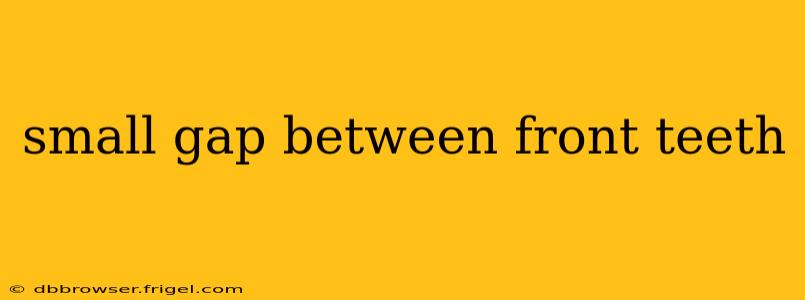A small gap between your front teeth, often called a diastema, is a common occurrence. While some people choose to close this gap for aesthetic reasons, many find it charming and unique. This comprehensive guide explores everything you need to know about small gaps between front teeth, addressing common concerns and offering informed perspectives.
What Causes a Small Gap Between Front Teeth?
Several factors can contribute to the development of a diastema. These include:
- Genetics: A family history of diastemas significantly increases your likelihood of having one. The size and shape of your teeth and jaws are largely determined by genetics.
- Size Discrepancy: If your teeth are smaller than the jawbone, gaps can naturally appear. This is particularly true if the lateral incisors (the teeth next to your central incisors) are significantly smaller than the central incisors.
- Gum Tissue Issues: Excessive gum tissue growth or an uneven gum line can create the illusion of a gap or actually contribute to the space.
- Tongue Thrusting: Habitual tongue thrusting, where the tongue rests against the front teeth, can push them apart over time. This is often more relevant in childhood.
- Missing Teeth: The absence of teeth can cause neighboring teeth to shift and create gaps.
Is a Small Gap Between Front Teeth a Problem?
For many, a small diastema is purely a cosmetic concern. It doesn't typically impact chewing function or oral health. However, if the gap is significantly large, it might affect speech or food trapping. Ultimately, whether a small gap is a "problem" is entirely subjective and depends on your personal preference.
How Can I Close a Small Gap Between My Front Teeth?
Closing a diastema is achievable through various cosmetic dentistry procedures. These include:
- Braces: Traditional braces, Invisalign (clear aligners), or other orthodontic treatments gradually shift teeth into the desired position, closing the gap. This is generally a longer-term solution.
- Veneers: Thin porcelain shells are bonded to the front of teeth, effectively concealing the gap and improving the overall appearance. This is a faster method than orthodontics.
- Bonding: A composite resin material is applied directly to the teeth to fill in the gap. This is a less invasive and more affordable option compared to veneers.
What are the Pros and Cons of Closing the Gap?
Pros:
- Improved Aesthetics: Many people feel more confident with a straighter smile.
- Enhanced Self-Esteem: Closing a gap can boost self-image and overall well-being.
- Improved Oral Hygiene: A closed gap may make cleaning teeth easier.
Cons:
- Cost: Cosmetic procedures can be expensive.
- Treatment Time: Orthodontic treatment, in particular, can take months or even years.
- Potential for Complications: Any dental procedure carries a small risk of complications.
How Much Does it Cost to Close a Gap Between Teeth?
The cost varies considerably depending on the chosen treatment, the severity of the gap, and the dentist's fees. Braces can range from a few thousand to tens of thousands of dollars, while veneers and bonding are typically less expensive. It's essential to consult with several dentists for accurate pricing and treatment plan options.
Will My Gap Get Bigger or Smaller Naturally?
The size of a diastema may remain stable, grow slightly larger, or, less commonly, even shrink naturally over time. This depends on several factors, including the underlying causes mentioned earlier. If you're concerned about its change, regular dental check-ups are recommended.
Can I Fix a Small Gap Between My Front Teeth at Home?
No, you cannot effectively close a diastema using home remedies. At-home solutions will not provide lasting results and might damage your teeth. Only a qualified dentist can provide safe and effective treatment options.
Conclusion
A small gap between your front teeth is often a harmless cosmetic variation. Whether you choose to keep it or close it is a personal decision. This guide has provided a comprehensive overview of the causes, treatment options, and considerations involved. Remember to consult with a qualified dentist for personalized advice and a tailored treatment plan that addresses your unique situation.
